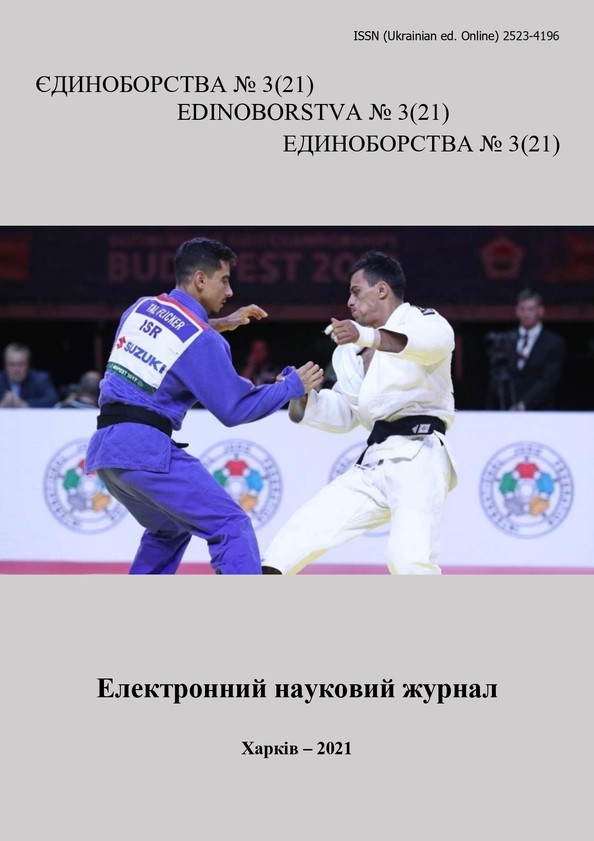Assessment of the level of functional state and the course of a specific biological cycle of cyclists and wrestlers 15-16 years
DOI:
https://doi.org/10.15391/ed.2021-3.04Keywords:
freestyle wrestling, cycling-MTB, specific biological cycle, cardiovascular systemAbstract
Purpose: to determine the
functioning of the cardiovascular and reproductive system of cyclists and wrestlers 15-16 years
under the influence of specific physical activity. Material and methods. 14 athletes took part in the
research, 7 of them were freestyle wrestling (3 – I category, 4 – candidates for master of sports)
and 7 – Mountain Bike (MTO) races (4 – I category, 3 – candidates for master of sports). Research
methods: theoretical analysis and generalization of scientific and methodological literature,
pedagogical and biomedical research methods, methods of mathematical statistics. Results: the
analysis of educational programs (freestyle wrestling, cycling-MTV) of the age group of 15-16
years showed that in these kinds of sports a different mode of educational and training work during
the annual cycle. So, for freestyle wrestling athletes in the age group 15-16 years old, special
physical training is planned for 100 hours, psychological training for 20 hours, competitive
training for 42 hours, for 70 hours – rehabilitation means for 6 hours – medical control, while
female cyclists – MTB is 12 hours more than general physical training, 144 hours more – technical
and tactical. After the training year, the analysis of the trainers' plans showed that in freestyle
wrestling, the percentage of general physical training has changed and amounted to 16 %, special
physical – 24 %, technical and tactical – 33 %, psychological – 4 %, while in cycling general
physical training – 19 %, special physical – 25 %, technical and tactical – 34 %, psychological – 6
%. Special and technical-tactical work by 1 % and psychological work by 2 % more were
performed by cyclists relative to wrestlers. Comparison of the indicators of the cardiovascular
system of female athletes showed a statistical difference in systolic blood pressure (t=3,60; t=8,92;
p<0,001), in diastolic blood pressure (t=3,56; t=6,00, p<0,001), in the aerobic metabolic capacity
(t=5,08; t=7,07; p<0,001), in the anaerobic metabolic capacity (t=12,20; t=8,14; p<0,001).
According to a survey of female athletes, it was determined that in September 2019, 33 % of
athletes 15-16 years old had irregular menstruation and 67% – regular, in December 2019 4 3% –
irregular and 57 % – regular, in May 2020 50% – irregular and 50 % – regular, in September 2020
57 % – irregular and 43 % – regular menstruation. Conclusions. The analysis of curricula for the
chosen sport and training plans of coaches by types of training showed that the specificity of the
training process is the specificity of the discipline in which relatively independent types are clearly
visible, and the distribution of training and competitive physical loads is interconnected with the
stage of training. Comparison of the indicators of the cardiovascular system of female athletes 15-
16 years old showed that higher performance in cyclists as a result of training (physiologically
athletic heart. At the same time, among wrestlers it was recognized as more optimal indicators of
the heart muscle for further improvement of sportsmanship. The negative dynamics of the ovarian
cycle at the age of 15-16 years was determined, which amounted to 21 % of irregular menstruation.
References
Богданова, Е.А. (2000). Гинекология детей и подростков: руководство для врачей. МИА, Москва.
Велосипедний спорт (велоспорт-шосе, велоспорт-трек, велоспорт-МТБ, велоспорт-ВМХ). (2017). Навчальна програма для дитячо-юнацьких спортивних шкіл, спеціалізованих дитячо-юнацьких спортивних шкіл олімпійського резерву, спеціалізованих навчальних закладів спортивного профілю та шкіл вищої спортивної майстерності. Київ.
Иорданская, Ф.А. (2012). Мужчина и женщина в спорте высших достижений. Проблемы полового диморфизма : монография. Сов. Спорт, Москва.
Мищенко, B.C. (1999). Функциональные возможности спортсменов. Здоровье, Киев. Похоленчук, Ю.Т., & Пангелов, Б.П. (2000). О сохранении здоровья (менструальной функции) и работоспособности спортсменок в период занятий спортом. Наука в олимпийском спорте, 89-96.
Пруднікова, М.С. & Чуб, О.О. (2011). Дослідження рівня морфо-функціонального стану юних велосипедисток 12-14 років, які спеціалізуються в БМХ. Педагогіка, психологія та медико-біологічні проблеми фізичного виховання і спорту, 3, 131-133.
Пруднікова, М.С. (2011). Побудова тренувального процесу юних велосипедисток 12-15 років в період становлення СБЦ (Автореф. дис. … канд. наук з фіз. вих.). Харків, Україна.
Шандригось, В.І., Яременко, В.В., Латишев, М.В., Первачук, Р.В. , & Чікало, В.Ю. (2019).
Боротьба вільна: чоловіки, жінки. Навчальна програма для дитячо–юнацьких спортивних шкіл, спеціалізованих дитячо–юнацьких шкіл олімпійського резерву, шкіл вищої спортивної майстерності та спеціалізованих навчальних закладів спортивного профілю. АСБУ, Київ.
Шахлина, Л.Г. (2002). Медико-биологические основы управления процессом спортивной тренировки женщин. Наукова думка, Киев.
Шахмурадов, Ю.А. (1997). Вольная борьба. Научно-методические основы многолетней подготовки борцов. Высш. школа, Москва.













